

![]()
BORDER COLLIE COUSINS
THE SHETLAND SHEEPDOG
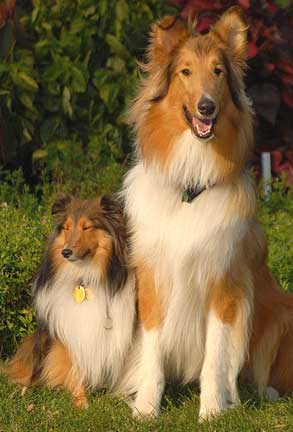
A Shetland Sheepdog and a Rough Collie
(© 12 October 2007 by "Chris"
originally posted to Flickr.com on 12 October 2007 by Pharaoh Hound
Licensed under the Creative Commons Attribution 2.0 Generic.)
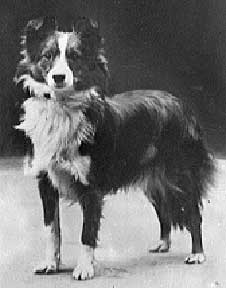
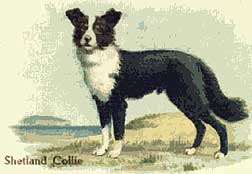 Left, "Champion Lassie" an early Sheltie show dog, looks more like a miniature Border Collie than a miniature Collie. Her head is broad, her muzzle relatively short, and she does not have the arched neck of today's Sheltie.
Left, "Champion Lassie" an early Sheltie show dog, looks more like a miniature Border Collie than a miniature Collie. Her head is broad, her muzzle relatively short, and she does not have the arched neck of today's Sheltie.
Right, originally, the Sheltie was called the "Shetland Collie", as it is on this cigarette card from 1911. But once the dog began to be shown, the Collie fancy protested the use of the name Collie as their proprietary right.
The Shetland Sheepdog (Sheltie) that is extant today is purely an invention of the dog fancy, though there are a few people (principal among them, Linda Rorem) who use the Sheltie for herding. Once, the Shetland Sheepdog was a useful dog. According to Dr. Sue Ann Bowling, a physicist and geophysicist with an interest in animal genetics, "the original stock [of the Shetland Sheepdog] probably consisted of Scandinavian herding dogs from the same stock as the Norwegian Buhund or the Icelandic dog. The Nordic herding dogs are rarely mentioned in the history of the breed, but there is every reason to assume that the original Norse settlers [in the late 8th and 9th centuries] brought along their dogs as well as their...sheep, cows and horses. There is archaeological evidence of such dogs dating from before the transfer of the Shetland Islands to Scotland [in 1470]."
The original Shetland collies were in all likelihood not sheep herding dogs, but "toon [town or farm] dogs and were mainly used as watch dogs to keep the sheep and other domesticated animals out of the enclosed arable land around a croft or farm" says James R. Nicolson quoting Dr. Stanley H. U. Bowie, a geologist and native Shetlander. Bowie went on to say that "there is no record of them having been used for 'driving, penning or catching sheep'." Other writers have disputed this point based on similar small collie-type dogs used in the Orkneys and Faroe Islands to chase down a sheep, catching it by the shoulder wool or foreleg and bringing it to the ground. Linda Rorem believes that Shetland Sheepdogs "were used to work a variety of livestock in the rugged, rocky landscape of the Shetland Islands...[and were] well suited for working in the harsh environment with little food".
As to what the original looked like, Nicolson quotes Agnes Leask, also a native Shetlander, as saying "The old, old dog in Shetland was a smaller dog still than the border collie, but not as small as the present day Shetland sheepdogs. They were mostly black. Some of them had a bit of white, some of them had black, white and a bit of tan. Black predominated...They were all bred out. The crofters saw that the dogs the shepherds from Scotland brought in to look after the big estates were much more efficient at running out and gathering the sheep...[and] they started crossbreeding...".
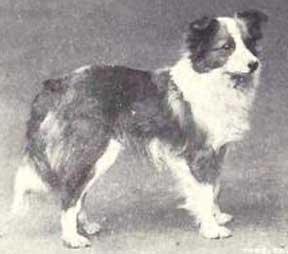
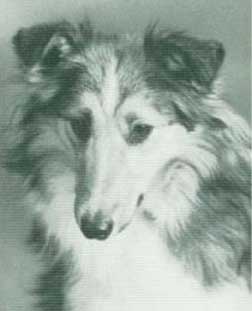 Left, a Shetland Sheepdog from 1915, still looking toward it's roots in the original "toon dog" but beginning to change. (From Dogs of all Nations by W. E. Mason and in the Public Domain.)
Left, a Shetland Sheepdog from 1915, still looking toward it's roots in the original "toon dog" but beginning to change. (From Dogs of all Nations by W. E. Mason and in the Public Domain.)
Right, by 1935 the Shetland Sheepdog had become a regular little collie.
Nicholson quoting Bowie points out that in "1908 the Shetland Sheepdog Club was formed in Lerwick...however, [when] in 1914 an English club was formed...rivalry broke out between breeders who wanted to maintain the original-type dog and those who wished to breed a miniature show collie. The latter variety is dominant today and it is doubtful if the original type is to be found in Shetland..."
According to Linda Rorem, there are a few people using Shelties today in regular farm work. She mentions a woman in Poland who uses a Sheltie to control her flock of 200+ geese. Those who participate in herding activities with them find them natural workers. Foremost among them is Rorem, a herding dog historian, all-breed sheepdog trainer, an all-herding-breeds trials judge, and one of the founder of the American Herding Breed Association, and . She has also used her own shelties to herd geese, ducks, sheep, goats, and in wild goose control work.
Resources:
American Herding Breed Association.
Bowling, Sue Ann. "Shetland Sheepdog Breed History"
Nicolson, James R. "Lost Dogs, or Whither the Shetland Sheepdog", Shetland Breeds: Little Animals, Very Full of Spirit, Ancient, Endangered, & Adaptable, Posterity Press Inc., 2003.
Rorem, Linda. "Herding With the Shetland Sheepdog: A Pursuit in Working with Natural Instincts and Abilities" on Herding on the Web
Copyright © 2013 by Carole L. Presberg
Return to
![]()
BORDER COLLIE COUSINS
THE OTHER WEB PAGES WE MAINTAIN
These web pages are copyright ©2013
and maintained by webmeistress Carole Presberg
with technical help from webwizard David Presberg
ALL RIGHTS RESERVED
If you are interested in using ANY material on this website, you MUST first ask for permission.